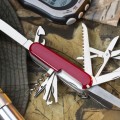Last Updated on August 5, 2023 by Dean Anderson
To most iconic of all knives is the Bowie knife. It was a large knife with a fixed blade and an edge behind the point. It was used for hunting and camping in the frontier lands.
Most famously, it was also used for fighting. The Sandbar fight in 1827 started as a duel between two men including Jim Bowie but ended up as a bloody battle between the duelist’s supporters. Jim Bowie survived only to die later at the Alamo.
Are you looking to purchase a survival knife or bushcraft knife? If so, then read this complete buying guide for survival/bushcraft knives.
What are Bushcraft Knives?
A bushcraft knife is a knife that helps you survive hence the alternative name, survival knife. This survival situation does not have to be confined to wilderness locations. Any number of disasters around the world provide evidence that a survival knife is useful in many circumstances.
Of course, a bushcraft knife can also be useful in a wide range of less extreme situations. These include camping, boating, hiking, backpacking, and hunting. You might even find it useful around the home.
The uses that a bushcraft knife can be put to are limited only by your imagination. Common uses are of course cutting and chopping. A robust survival knife can also be used for digging, building a shelter, splitting wood, making a fire, preparing a meal, and signaling.
In the tradition of the Bowie knife, a bushcraft knife can be used for self-defense. Less gruesomely, it can also be used for first aid.
How Big a Knife Do You Need?
In the movie, Crocodile Dundee, Mick Dundee is a wild man from the Australian outback. When mugged in New York, he asks why he should give the mugger his wallet. On being told that he has a knife, he famously suggests that it’s not a knife and reveals his own impressive bushcraft knife.
What size of knife do you need for effective survival use? Is bigger always better? There are arguments on both sides.
If the blade is very long it can become unusable for fiddly tasks such as preparing small game for the pot or precision carving. On the other hand, a small blade is a very poor tool for chopping wood or splitting logs.
There is an argument for having both a small knife and a larger one but if you have to choose, aim for a compromise of around 10 inches including a 5-inch blade.
Fixed or Foldable
A fixed blade is likely to be more robust than a foldable blade. Introducing a joint into the knife means there is an inherently weak point.
When strength is the priority a fixed blade wins out. Choose a fixed blade if the knife will be used for batoning, pounding, chopping or levering.
The downside of a fixed blade is the size. A folding knife will allow you to reduce the overall length of the knife for carrying but it does put your survival at risk. When you depend on this essential survival tool why compromise on its robustness?
Tangs and Handles
The tang of a knife is the part of the blade that extends into the handle of your knife. It provides the knife with strength if it extends the full length of the handle. If it only extends a short way into the handle, it has the potential to break.
Even if the tang extends the full length of the handle a poorer quality knife will have a tang made of a narrow strip of metal. Quality knives have tangs that extend fully to the back of the handle but are also the full height of the handle. This makes it much more resilient for heavy-duty work.
Even in a situation where the handle has broken or worn, a full tang knife can be used with the addition of a makeshift handle. A DIY handle can be made from a wrap of material or cord.
Look for an exposed tang on the handle or check the specification of any knife you are considering. Select a handle that is suitable for the knife. A heavy knife needs a heavier handle.
Handles in wood, bone or combinations of rubber and plastic are all potentially good. Consider the care of the handle to extend the life of the knife. Metal handles are durable but get hot or cold depending on the conditions, so they may be uncomfortable to use.
The Blade
Bushcraft knives come in two main materials. Stainless steel is tough, doesn’t rust, and lasts ages. They can lose their edge more quickly than a carbon steel knife.
Carbon steel keeps an edge longer. It also deteriorates in poor conditions. If you are happy to sharpen your knife regularly, chose stainless steel.
Despite the iconic style of the Bowie knife of legend, a sharpened upper edge isn’t appropriate for most survival conditions. It may be useful in a knife fight in the old west, but it is a disadvantage for most woodland work.
Batoning involves splitting wood by hammering the back of the knife blade as the sharp edge splits branches. This is not possible if the upper edge is sharpened. Double-sided dagger style blades are also unusable for fire lighting, or for careful thumb control when carving.
A serrated blade may look effective but it is more difficult to sharpen than a straight-edged blade. A straight-edged blade can even be sharpened on a smooth stone if a proper sharpener or whetstone is not available.
Check the width or thickness of the blade. They can vary and you don’t want a blade that flexes much. Chopping and digging need blades of about 3/16 or 4/16 of an inch.
Last but Not Least
Try before you buy it. Bushcraft knives are survival tools and so might have to be used in testing conditions. Make sure your bushcraft knife fits into your hand and you can wield it effectively.
Read reviews of the best bushcraft knives.

Eight years ago, I took a risk and left a miserable office job to follow a lifestyle career that involved my love for the great outdoors. I’ve taken my love for camping, hiking and travel to the next level by running my small campground with a friend near Portland, Oregon. It’s for way less money but this has truly been a dream come true and the running involves lots of family and friends.
The next evolution of that was to get online and start allcampingstuff.com. At our campground, I spend a lot of time setting up camping equipment for customers and disposing of the garbage products they leave behind. If I can help just a few people with advice on good camping gear, then this website venture will be worth it.
So, if you want to avoid the duds and spend your money wisely you’ve hopefully come to the right place.







